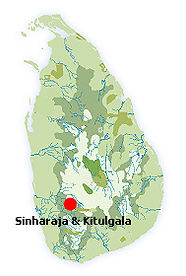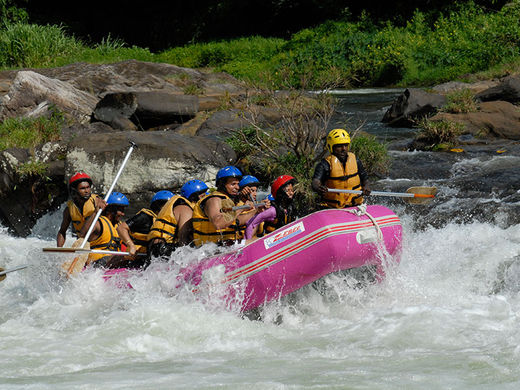KITULGALA
West of the road from Kandy to Nuwara Eliya, Kitulgala is a popular adventure-sports centre located amid thickly forested hills. Most visitors are the young and energetic of Colombo, but foreign visitors are also starting to discover the region's white-water rafting, jungle trekking, birdwatching and cave exploration.
The town’s other main claim to fame is that David Lean filmed his 1957 Oscar-winning epic Bridge on the River Kwai here on the banks of the Kelaniya Ganga, though there's little physical evidence left to see.
A few kilometres from Kitulgala is a large cave system where the 28,500-year-old remains of early humans were discovered. Many hotels in the area can arrange a guide to the caves.
White Water Rafting is what attracts the seekers of adventure. The river at its scenic middle section consists of 10 level two, and level three rapids. They are separated by a quietly flowing patch of the river. The higher part is more of a challenge that is recommended to the more experienced.It is a picturesque little riddle of a town and village that you can unravel at leisure enjoying every moment of this Eden Resort in Sri Lanka.

Kitulgala Information and Google Map
PROVINCE : SABARAGAMUWA PROVINCE
DISTRICT : KEGALLE DISTRICT
POPULAR : NATURE,RAFTING,WATER SPORT,RIVER
WEATHER : 32 °C
PHOTO GALLERY
Historical Background
The significance of the Sinharaja tropical rainforest was recognized in 1989 when UNESCO declared it a protected World Heritage Site. The Sabaragamuwa province, in which Sinharaja sits, is of great archeological importance with the discovery of Stone Age settlements in Balangoda. Considered to be the earliest settlement on the island, the excavated artifacts are currently on display in the National Museums of Ratnapura and Colombo. Sri Pada, also known as Adam’s Peak, is a significant place of worship for devotees of many faiths. It is believed that Sri Pada is one of three sacred locations on the island that was visited by Lord Buddha. Each year, thousands of devotees and a steady trickle of travellers climb to the top of this sacred mountain during the season from December to April.
Shopping
Ratnapura town is filled with gem shops where you can buy gemstones as well as gem studded jewellery. Most places have their workshops at the back where the coarse gem stones found in the depths of the soil are cut and polished. The National Gem & Jewellery Authority regulates Sri Lanka's gem industry and it is important that a certificate of authenticity is obtained.
Events
Birding in Sinharaja: Head to Sinharaja rain forest during November to March, April and August to spot the Mixed Species Feeding Flocks and other forest birds.
Saman Devala Perehera: The Saman Devala in Ratnapura hosts an annual Perahera on the full-moon Poya day of July or August. This pageant displays traditional folklore, music and the rhythmic dance forms of the Sabaragamuwa region. Dancers, drummers, Chieftains in traditional attire, and elephants dressed in glittering cloaks are all part of this colourful pageant.
Climate
The Sinharaja Reserve has a wet equatorial climate and, in common with the south west highlands which it fringes, is one of the wettest part of Sri Lanka. Dryest months are January to March and July to September. Sri Lanka is affected by two monsoons which generally means that there is good weather somewhere. The main south-west (“yala”) monsoon brings rain to the west and south-west coasts and hills largely between May and July. The north-east (“maha”) monsoon hits the east coast predominantly from November to January. There is also an inter-monsoonal period of unsettled weather in October.
Sights
Nature lovers should not miss the Sinharaja tropical rainforest. The Sinharaja is a biological treasure trove with numerous species of unique fauna and flora, not found anywhere else in the world. It covers about 11,000 hectares of low land rain forest and is a valuable storehouse of scientific knowledge. Dense, dark, muggy and mysterious, Sinharaja Rain Forest is teeming with life. Tall trees with rustling leaves; gigantic ferns and wild orchids; gushing waterfalls and gurgling streams; creaking crickets and butterflies fluttering by – all nature’s wonders, untouched by man. Apart from the very distinct atmosphere, which is created by this great cacophony of noise and movement, Sinharaja is particularly renowned as a hotspot for birdlife. 34 out of 36 bird species endemic to Sri Lanka are found here
En route to the Sinharaja is the town of Ratnapura, home to a long-established gem industry. It is here that villagers from the surrounding gem fields gather to sell their precious stones to local gem merchants, international traders and tourists. In Sri Lanka, traditional jewellery worn by local women is set in 22 carat gold and is considered a valuable investment and a basic accessory. According to tradition, even the poorest of families will want to purchase a pair of gold earrings for a new-born girl.
Kitulgala offers rafting on Grade 3 and 4 rapids down the Kelani River. Travel through jungle-clad hills and plantations growing low-country tea and rubber. Just across the Kelani River is a small, lush primeval forest, home to about 54 rare species of birds, including the indigenous white owl. Jungle trekking, outdoor camping, and mountain biking is also possible. A two-hour drive from Kitulgala will take you to Adam's Peak, a 2,234m mountain that is a sacred pilgrimage site for people of many faiths. The climb to the summit is possible from December to April and is recommended for the active walker.








